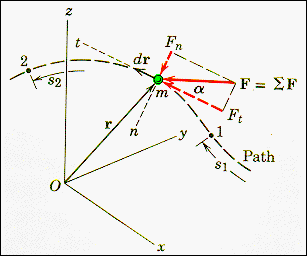|
Work,
Energy, and Power
The
diagram shows a point object (green) of mass, m, acted on by a force, F,
that is the resultant of all forces acting on the object. The object is
moving along the dotted path shown, and s is the distance it moves along
this path. The position of the object in the (x, y, z) coordinate system
shown is described by the vector, r, and as the point moves a distance
ds along the path, the vector changes by an amount dr that is tangential
to the path. In moving this distance the force does work on the object
that is given by: Work = dU = F.dr,
where the dot product between the force vector and the displacement vector
gives the scalar quantity, work.
If
the force is resolved into components along the tangent to the path:
Ft
= Fcos(a),
and normal to that path:
Fn
=Fsin(a),
the work is seen to be done only by the tangential component
and dU = F cos(a)
ds,
where a
is the angle between the tangent and the resultant force vector, ds is
the distance moved along the path, and is equal to the magnitude of dr.
|
|
|
|
|
|
|
|
|
|
|
|
|
